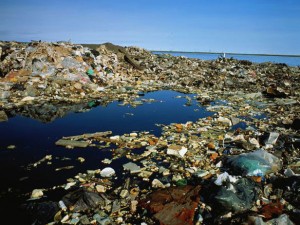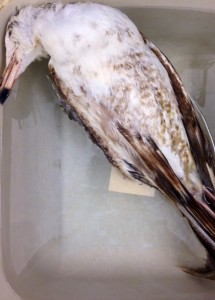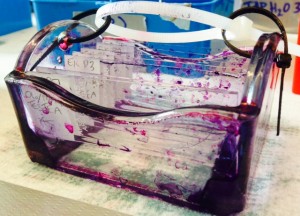As this is my first post, I would like to briefly introduce myself: I am Emilie Kurth, a rising senior here at Puget Sound. I am majoring in Biology, minoring in French, and I am also a member of the Honors Program. This summer is my first experience conducting research outside of a controlled classroom setting. I have found this change to be liberating in how I approach my scientific questions and the relaxed environment has also encouraged me to become more self-motivated as well as innovative with my biological thinking.
My research project requires a relative amount of creativity because it combines two rarely linked fields: neuroscience and ecology. I am studying the reproductive and neurophysiological effects of chronic plastic exposure in two species of seabirds: the Northern Fulmar (Fulmarus glacialis) and Sooty Shearwater (Puffinus griseus). Unfortunately, these seabirds are two of many species known to ingest plastic, which represents the largest global marine pollutant, measuring at 315 billion pounds in 2009. Plastics are used universally, and in order to optimize their functionality and durability, many plastics are manufactured with chemical additives such as bisphenol A (BPA), polychlorinated biphenyls (PCBs), nonylphenols (NPs), and polybrominated diphenyl ethers (PBDEs), all of which interfere with the neuroendocrine system. Once seabirds have ingested plastics, these chemical additives can leach through the blood stream and into major organs. I am researching to examine if chemical additives have permeated the brain, (particularly the hypothalamus which controls eating, sleeping reproduction, etc.), and the gonads (ovaries and testicles) of juvenile Northern Fulmars and Sooty Shearwaters. I am searching for abnormalities of size and structures in these anatomical regions using dissection, weighing, and microscopic techniques.
My past three weeks working in the labs of Peter Hodum (PhD, Biology Department) and Siddharth Ramakrishnan (PhD, Biology and Neuroscience Departments) have focused predominantly on learning and trouble-shooting my methods. I have practiced my procedure on several ill-fated California Gulls donated by Slater Museum. And from my practice, I have perfected my techniques of extracting the gonads, fixing them, and then slicing them into 5-20 µM thick slices (which is extremely small) using the Cryostat, which essentially is an extremely precise and high-tech deli slicer. Additionally I have learned the art of staining slides, where the histology slides to which the
sliced tissues have adhered are dipped into a series of chemicals that tinge the tissues with purple, pink, and blue hues, allowing for observation of surface details beneath a fluorescent microscope.
Thus far, fixation of the brain has served as the largest challenge, wherein I produced a flubber-esque brain and unintentionally splashed it all over my laboratory station (whoops!). However, today I dissected a perfectly fixed brain (after Siddharth suggested sawing holes into the skull so the fixative would better permeate the tissue), and it is currently soaking in a second fixative where it will stay for several days until it is ready to
undergo slicing and analysis. I am optimistic that this brain will offer much better results than the last few, and once I have solidified my procedure with the brain, I can finally begin to analyze the Northern Fulmars and Sooty Shearwaters!
Until next time!




